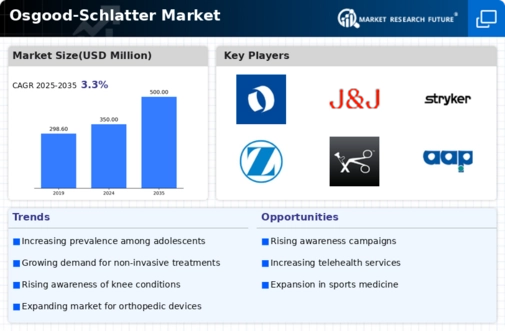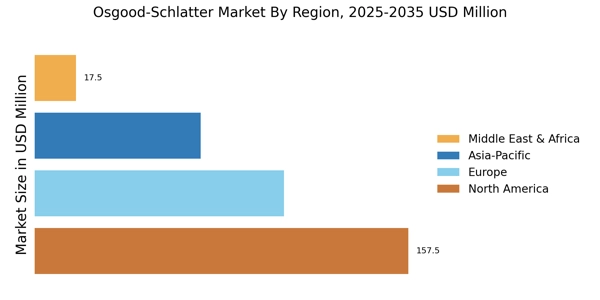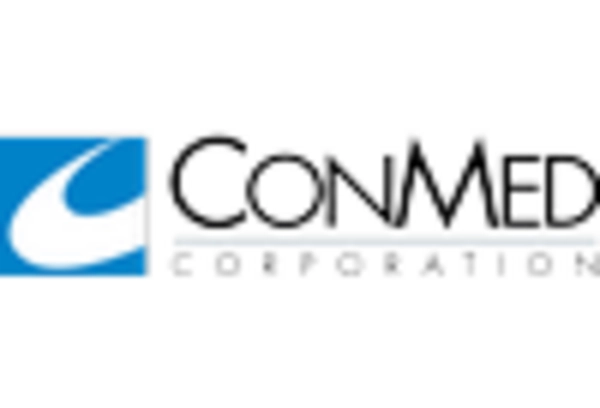Advancements in Medical Technology
The Osgood-Schlatter Market is significantly influenced by advancements in medical technology, which have led to improved diagnostic and treatment options. Innovations such as ultrasound imaging and MRI have enhanced the ability to accurately diagnose Osgood-Schlatter disease, allowing for timely intervention. Furthermore, the development of minimally invasive surgical techniques and advanced physiotherapy methods has improved recovery outcomes for patients. As these technologies become more accessible, healthcare providers are likely to adopt them, thereby increasing the overall efficiency of treatment protocols. This shift not only benefits patients but also propels the Osgood-Schlatter Market forward, as more individuals seek out these advanced treatment options.
Growing Focus on Youth Sports Health
The Osgood-Schlatter Market is witnessing a growing focus on the health and well-being of youth athletes. With an increasing number of children participating in organized sports, there is a heightened awareness of sports-related injuries, including Osgood-Schlatter disease. Schools and sports organizations are now prioritizing injury prevention and management strategies, which include education on proper training techniques and the importance of rest. This proactive approach is likely to lead to earlier diagnosis and treatment of Osgood-Schlatter disease, thereby expanding the market. As more stakeholders recognize the importance of addressing these health issues, the Osgood-Schlatter Market is expected to benefit from increased investment in preventive measures and treatment options.
Increased Investment in Sports Medicine
The Osgood-Schlatter Market is benefiting from increased investment in sports medicine, which encompasses a wide range of services aimed at preventing and treating sports-related injuries. As the popularity of youth sports continues to grow, there is a corresponding rise in funding for sports medicine programs and facilities. This investment not only enhances the quality of care available to young athletes but also promotes research and development in the field. Consequently, the Osgood-Schlatter Market is likely to see an influx of innovative treatment options and preventive measures, as stakeholders recognize the importance of addressing the health needs of young athletes. This trend may lead to a more robust market landscape, characterized by a diverse array of services and products.
Increased Incidence of Osgood-Schlatter Disease
The Osgood-Schlatter Market is experiencing a notable rise in the incidence of Osgood-Schlatter disease, particularly among adolescents engaged in sports. This condition, characterized by knee pain and inflammation, is often triggered by physical activities that involve running, jumping, or kneeling. Recent data indicates that approximately 20% of young athletes may experience symptoms related to this condition, leading to a growing demand for effective treatment options. As awareness of the disease increases, healthcare providers are more frequently diagnosing and treating affected individuals, thereby expanding the Osgood-Schlatter Market. This trend suggests that as more young athletes participate in sports, the prevalence of Osgood-Schlatter disease may continue to rise, further driving market growth.
Rising Demand for Non-Surgical Treatment Options
The Osgood-Schlatter Market is experiencing a rising demand for non-surgical treatment options as patients and healthcare providers seek less invasive alternatives. Many individuals prefer to manage their symptoms through physical therapy, bracing, and anti-inflammatory medications rather than opting for surgical interventions. This trend is particularly evident among younger patients, who may be hesitant to undergo surgery. As a result, the market for non-surgical treatments is expanding, with various products and services being developed to cater to this demand. The increasing preference for conservative management strategies is likely to shape the future of the Osgood-Schlatter Market, as more individuals seek effective yet non-invasive solutions.


















Leave a Comment